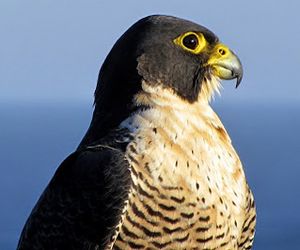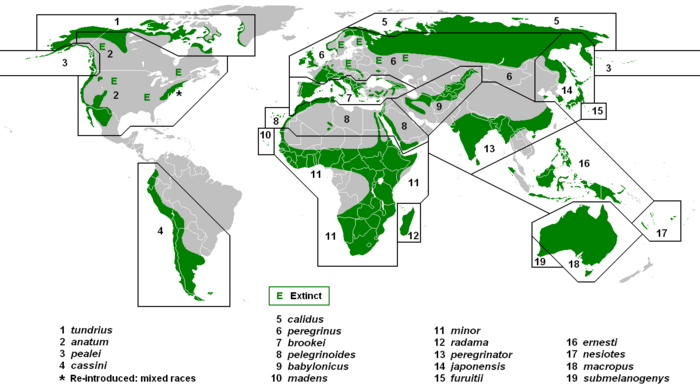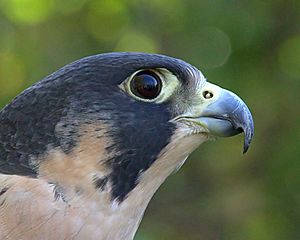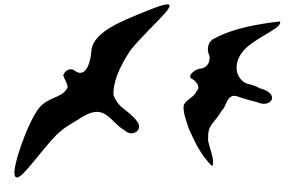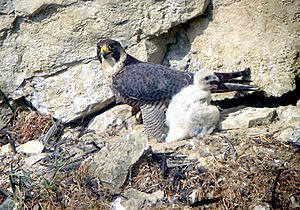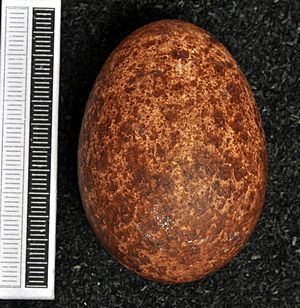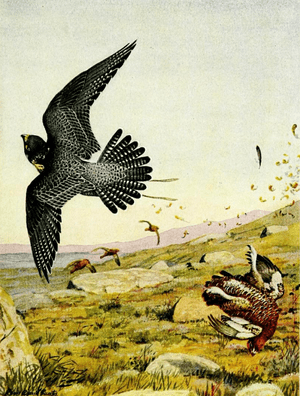Peregrine falcon facts for kids
Quick facts for kids Peregrine falcon |
|
|---|---|
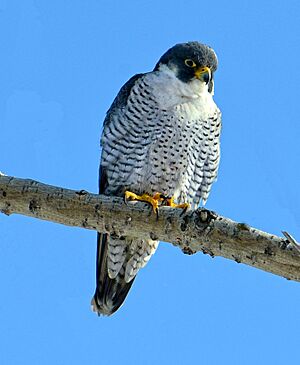 |
|
| Male in Toronto, Ontario, Canada | |
| Conservation status | |
| Scientific classification | |
| Genus: |
Falco
|
| Species: |
peregrinus
|
| Subspecies | |
|
18–19, see text |
|
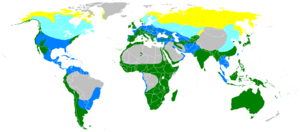 |
|
| Global range of F. peregrinus
Breeding summer visitor Breeding resident Winter visitor Passage visitor |
|
| Synonyms | |
|
|
The peregrine falcon (Falco peregrinus) is a super-fast hunting bird, also known as a raptor. It's famous for being the fastest animal on Earth! This falcon is about the size of a crow. It has a blue-grey back, white belly with stripes, and a black head. Female peregrine falcons are usually bigger than males. This is common for birds of prey that hunt other birds.
You can find peregrine falcons almost everywhere in the world. They live from the cold Arctic to warmer tropical areas. They avoid extremely cold places, very high mountains, and most dense rainforests. The only large landmass without them is New Zealand. This makes them the most widespread raptor and one of the most common wild bird species globally. They often hunt pigeons, especially in cities where pigeons are plentiful.
The peregrine falcon is great at living in cities. It uses tall buildings for nests, just like cliffs. It also finds plenty of prey like pigeons and ducks there. Its name, "peregrine," means "wandering" in Latin. This refers to how many northern populations migrate long distances. There are about 18 or 19 different types, called subspecies, which look slightly different.
These falcons mainly eat medium-sized birds. Sometimes, they also hunt small mammals, reptiles, or even insects. They become adults at about one year old. Peregrine falcons usually mate for life. They build their nests, called scrapes, on cliff edges or tall human-made structures.
In the past, peregrine falcons became endangered in many places. This was due to pesticides like DDT. After DDT was banned in the 1970s, their numbers grew again. This was thanks to protecting their nesting sites and releasing falcons bred in captivity.
People have used peregrine falcons for hunting, a sport called falconry, for thousands of years. They are highly valued for their hunting skills and how easily they can be trained. They have also been important symbols in different cultures and times.
Contents
Amazing Peregrine Falcon Features
Peregrine falcons are usually between 34 to 58 centimeters (13 to 23 inches) long. Their wingspan can be from 74 to 120 centimeters (29 to 47 inches). Females are much larger than males. Males weigh from 330 to 1000 grams (0.7 to 2.2 pounds). Females are heavier, weighing 700 to 1500 grams (1.5 to 3.3 pounds).
Adult falcons have bluish-black to slate-grey backs and long, pointed wings. Their wingtips are black. Their bellies are white or rusty with thin dark brown or black stripes. The tail matches the back, with thin stripes and a black tip. The top of their head and a "moustache" mark on their cheeks are black. This contrasts with their pale neck and white throat.
Their beak and claws are black. The upper beak has a special notch near the tip. This helps them kill prey by breaking the neck bones. Young falcons are browner and have streaked bellies instead of stripes.
The black patch of feathers below their eyes is called the malar stripe. Scientists found in 2021 that this stripe is bigger in sunny areas. It helps the falcon see better by reducing sun glare.
Peregrine Falcon Names and Types
The scientific name for the peregrine falcon is Falco peregrinus. This name was first used in 1771 by an English bird expert, Marmaduke Tunstall. The name Falco peregrinus comes from old Latin. Peregrinus means "one from abroad" or "traveler." This name likely came about because young falcons were caught during their travels, not from their nests. The word Falco is related to the Latin word for "sickle." This refers to the shape of the falcon's long, pointed wings when it flies.
There are many different types of peregrine falcons around the world. These are called subspecies. Scientists recognize about 18 or 19 subspecies. They all look a bit different depending on where they live. For example, some are darker, some are paler, and some are larger or smaller. The Barbary falcon, found in North Africa and the Canary Islands, is a very close relative. Some experts consider it a separate species, while others see it as a subspecies of the peregrine falcon.
Peregrine Falcon Life and Habits
Peregrine falcons mostly live near mountains, river valleys, and coastlines. They are also increasingly found in cities. In places with mild winters, they often stay in the same area all year. Only those that breed in very cold Arctic regions travel long distances for winter.
The peregrine falcon is famous for its hunting dive, called a "stoop." It soars very high, then dives steeply at incredible speeds. It hits its prey with one wing to stun it, then catches it in mid-air. The air pressure during such a fast dive could hurt a bird's lungs. But peregrines have small bony bumps in their nostrils. These bumps help guide the airflow away, making it easier to breathe.
To protect their eyes, falcons have special third eyelids. These eyelids spread tears and clear away dirt while they are diving.
Peregrine falcons can see very fast movements. Their eyes process images much quicker than human eyes. This helps them track fast-moving prey.
In the wild, peregrine falcons can live for almost 20 years. Many young falcons don't survive their first year. After that, their chances of survival improve. Larger hawks and owls can sometimes hunt peregrines. They can also be hurt by flying into human-made objects.
Incredible Speed of the Peregrine Falcon
The peregrine falcon is the fastest animal on Earth! During its hunting dive, or stoop, it can reach speeds over 320 kilometers per hour (200 miles per hour). Some reports even suggest speeds up to 389 km/h (242 mph). This amazing speed allows them to catch other fast-flying birds. It also helps them make quick turns to grab agile prey.
What Peregrine Falcons Eat
The peregrine falcon's diet changes depending on what birds are available. They mostly eat medium-sized birds. This includes pigeons, ducks, seabirds, and songbirds. Worldwide, they hunt between 1,500 and 2,000 different bird species. This is about one-fifth of all bird species! Their prey can range from tiny hummingbirds to large sandhill cranes.
In cities, where they often nest on tall buildings, they mostly eat pigeons. Rock doves, also known as feral pigeons, make up a large part of their diet. Other city birds like mourning doves and starlings are also common prey. Coastal falcons, especially the larger subspecies, mostly eat seabirds.
Sometimes, peregrines also hunt small mammals like bats, lemmings, mice, and squirrels. They might even catch small reptiles or insects. Very rarely, they have been seen catching fish.
Peregrine falcons usually hunt at dawn and dusk. This is when their prey is most active. In cities, they might even hunt at night, especially during migration season. They need open spaces to hunt. So, they often hunt over water, fields, or valleys. They look for prey from high up or from the air. Once they spot prey, they begin their fast dive. They usually catch their prey in mid-air. If the prey is too heavy, they drop it to the ground to eat.
Peregrine Falcon Reproduction and Life Cycle
Peregrine falcons are ready to have chicks when they are one to three years old. They usually mate for life. Each year, they return to the same nesting spot. Their courtship involves amazing aerial displays. The male catches prey and passes it to the female in mid-air. The female sometimes even flies upside-down to grab the food!
During breeding season, they protect their nesting area. Nests are usually at least 1 kilometer (0.6 miles) apart. This ensures there's enough food for the parents and their chicks. A pair might use several different ledges for nesting over the years.
Peregrine falcons make a simple nest called a scrape. The female scrapes a shallow dip in loose soil, sand, or dead plants. No extra nest materials are added. Cliff nests are often under an overhang. In some places, they use large tree hollows. In cities, they nest on tall buildings or bridges. These human-made structures are like the natural cliffs they prefer.
The parents defend their nest from other falcons, ravens, and gulls. If they nest on the ground, they also protect against mammals like foxes or bears. Larger birds of prey, like eagles or large owls, can sometimes hunt young falcons or even adults. Peregrines are very brave in defending their nests. They have even chased away much larger birds.
The female lays three to four eggs, sometimes one to five. The eggs are white to buff with red or brown marks. The female mainly incubates them for 29 to 33 days. The male helps during the day.
After hatching, the chicks, called "eyases," are covered in white down. Both parents hunt to feed their young. The parents might hunt up to 24 kilometers (15 miles) away from the nest. Chicks learn to fly, or "fledge," about 42 to 46 days after hatching. They stay with their parents for up to two more months, learning how to hunt.
Peregrine Falcons and Humans
Peregrine Falcons in Falconry
The peregrine falcon has been a highly valued bird for falconry for over 3,000 years. This sport involves hunting with trained birds of prey. Peregrines are admired for their athletic ability, eagerness to hunt, and calm nature. They are one of the easier falcons to train.
In falconry, the peregrine falcon flies above the falconer, waiting for prey to appear. Then, it performs its amazing high-speed dive to catch the prey. This speed helps it catch fast birds and deliver a powerful strike. Different sizes of peregrine subspecies are used to hunt various game birds, from small doves to large pheasants.
Trained peregrine falcons are also used at airports. They help scare away other birds to prevent bird-plane collisions. This makes air travel safer. During World War II, they were even used to intercept homing pigeons.
Saving the Peregrine Falcon
In the 1950s, 60s, and 70s, peregrine falcons faced a big problem. A pesticide called DDT was widely used. This chemical built up in the falcons' bodies and made their eggshells very thin. Because of this, many eggs broke before the chicks could hatch. In some areas, like the eastern United States, peregrine falcons completely disappeared.
After DDT was banned in the early 1970s, efforts began to help the falcons recover. Scientists and falconers worked together to breed peregrines in captivity. The chicks were raised carefully, often fed by hand puppets so they wouldn't get too used to humans. Once they were old enough, they were released into the wild using a method called "hacking." This involves placing them in a special cage at a cliff or tower for a few days to get used to their new home.
These recovery efforts have been very successful worldwide. The ban on DDT allowed the released birds to breed successfully. In the U.S., the peregrine falcon was removed from the endangered species list in 1999. In the United Kingdom and Canada, their numbers have also bounced back significantly.
Peregrine Falcons Today
Today, peregrine falcon populations are thriving in most parts of the world. They have adapted well to urban environments. They often nest on tall buildings, bridges, and cathedrals. These city falcons use the abundant pigeon populations for food. They also benefit from city lights, which allow them to hunt longer into the evening.
Many urban nesting sites are monitored by cameras, drawing public interest. However, living in cities can also bring challenges. Falcons can sometimes be affected by pollution or human-related issues.
For example, in Portland, Oregon, about ten percent of the state's peregrine nests are found within the city. In England, peregrines have become more common in cities, especially where natural nesting cliffs are scarce.
Peregrine Falcons in Culture
The peregrine falcon's impressive hunting style has often linked it to strength and courage. In Ancient Egypt, the sun god Ra was sometimes shown with the head of a falcon. Native Americans of the Mississippian culture (around 800–1500 AD) used the peregrine as a symbol of "sky power."
In the Middle Ages in Europe, nobles used peregrines for hunting. They considered the peregrine a bird fit for princes, just below the gyrfalcon, which was for kings. It was seen as "a royal bird, more armed by its courage than its claws."
Since 1927, the peregrine falcon has been the official mascot of Bowling Green State University in Ohio. In 2007, the U.S. state quarter for Idaho featured a peregrine falcon. It is also the official city bird of Chicago.
The book The Peregrine by J. A. Baker is a famous nature book. It describes the author's detailed observations of peregrine falcons over a winter in England. Many people consider it one of the best nature books ever written.
In 1999, the Suzuki Corporation named a new motorcycle "Hayabusa," which is Japanese for peregrine falcon. Suzuki claimed it was the fastest production motorcycle in the world at that time.
Images for kids
-
Illustration of the subspecies babylonicus by John Gould
-
A male Red-naped shaheen by its nest in Kerman, Kerman province, Iran
-
A juvenile of the subspecies ernesti in Mount Mahawu, North Sulawesi, Indonesia
-
An adult of either the subspecies pealei or tundrius by its nest in Alaska
-
Diving on a flock of common starling in Rome
See also
 In Spanish: Halcón peregrino para niños
In Spanish: Halcón peregrino para niños
- List of birds by flight speed
- Perilanner, a hybrid of the peregrine falcon and the lanner falcon (Falco biarmicus)
- Perlin, a hybrid of the peregrine falcon and the merlin (Falco columbarius)



